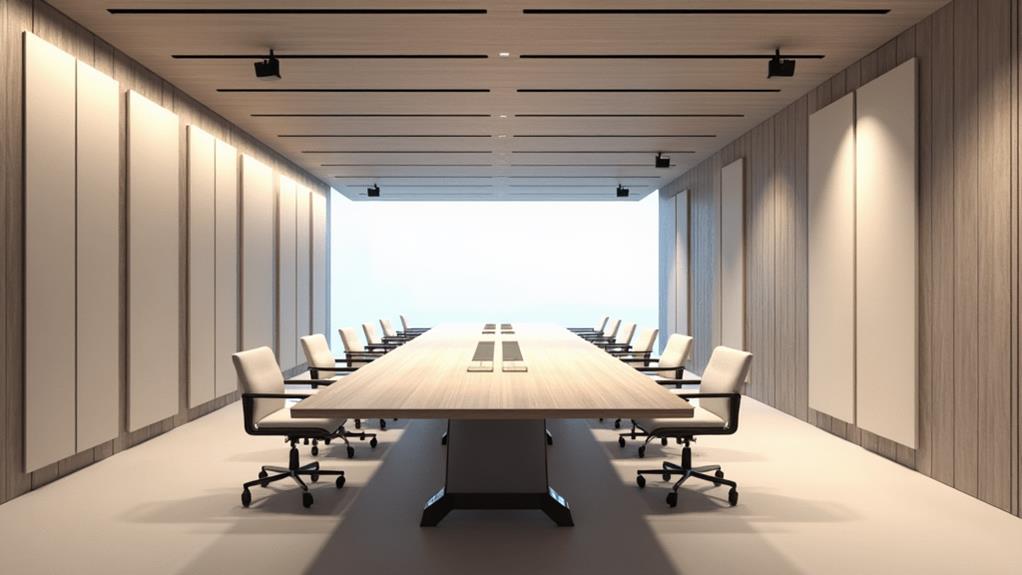Acoustics are crucial in commercial AV design, as they directly impact audio quality, intelligibility, and the overall user experience. Factors like reverberation, background noise, and uneven sound distribution can severely hamper communication and collaboration in spaces like conference rooms and classrooms. By understanding the science of acoustics, you can leverage solutions like sound absorption, diffusion, and isolation to create ideal acoustic environments. Integrating these principles with the right AV technologies can transform the quality of sound, leading to enhanced collaboration and engagement. To dive deeper into the intricacies of commercial acoustics, continue exploring the key principles and best practices.
Key Takeaways
- Proper acoustic management is crucial for achieving clear, intelligible speech and high-quality music reproduction in commercial AV environments.
- Controlling reverberation, echo, and background noise can enhance communication quality and improve overall user experience.
- Strategic placement of acoustic panels, diffusers, and other sound-absorbing materials can create a balanced, uniform sound field.
- Integrating acoustic solutions with the AV system design can optimize speech intelligibility, collaboration, and productivity in meeting spaces.
- Regular acoustic measurements and adjustments are essential to maintain optimal sound quality and performance over time.
Understanding the Science of Acoustics

Understanding the science of acoustics begins with recognizing that sound is a physical phenomenon. Sound waves interact with surfaces and materials, causing reflections, absorption, and diffusion that impact audio quality.
Essential AV equipment like ceiling baffles and acoustic panels play a pivotal role in managing these sound interactions. The volume, reverberation time, and background noise level of a room are key acoustic factors that affect human perception.
Effective acoustic design requires balancing absorption, diffusion, and isolation to create ideal listening conditions. Acoustic modeling and simulation tools enable predicting and optimizing the sound performance of a space.
Acoustic Challenges in Commercial AV
Designing effective commercial audiovisual (AV) systems requires grappling with a range of acoustic challenges. Echo, reverberation, and background noise can undermine speech intelligibility and music clarity. Sound leakage between spaces and uneven sound distribution in auditoriums further compound the problem. Addressing these issues is indispensable for achieving prime acoustic performance and comfort.
| Challenge | Impact |
|---|---|
| Echo and Reverberation | Unintelligible speech, loss of music clarity |
| Background Noise | Listener distraction, reduced communication quality |
| Sound Leakage | Disruption of neighboring spaces |
| Hard-Surfaced Rooms | Echoes and reverberation, hampered communication |
| Uneven Sound Distribution | Areas too loud or too quiet, subpar experience |
Implementing effective acoustic design, sound masking systems, and strategic use of sound-absorbing materials can help mitigate these challenges and deliver exceptional commercial AV experiences.
Principles of Acoustic Management

Effective acoustic management in commercial AV design centers on three key principles: sound absorption, sound diffusion, and sound isolation. Sound absorption uses materials that can soak up sound waves, reducing echo and reverberation.
Sound diffusion scatters sound waves to create a more uniform sound field, particularly useful in larger AV rooms. Modern video conferencing systems depend heavily on proper acoustics to guarantee clear communication during remote meetings.
Sound isolation prevents sound from traveling between different spaces, critical in multi-use buildings. Acoustic panels, carpets, and upholstered furniture can absorb sound, while diffusers and architectural features can scatter sound to improve room acoustics. Mastering these acoustic design principles is vital for high-quality audio-visual experiences in commercial settings.
Acoustic Solutions and Technologies
Acoustic panels with high sound absorption coefficients can be a powerful tool for reducing reverberation and enhancing speech intelligibility in commercial spaces. Sound masking systems that introduce low-level background noise can help mask distracting sounds and improve speech privacy in open office environments.
Strategically placed diffusers can scatter sound waves evenly to prevent harsh echoes and create a more uniform soundscape. Bass traps designed to absorb low-frequency sounds are crucial for controlling problematic rumble in small rooms.
Enhanced collaboration spaces benefit from acoustic treatments that support clear communication during video conferencing and team meetings. Integrating these acoustic solutions seamlessly with architectural design can enhance both the aesthetic and functional aspects of a commercial AV space, resulting in optimal acoustic performance.
Designing for Optimal Sound Quality

Ideal sound quality in commercial AV spaces requires a multi-faceted approach. Modern immersive audio solutions and 3D soundscapes are transforming how we experience sound in commercial settings.
Implementing appropriate acoustics is vital to ensure even sound distribution and clear communication. Poor acoustics and excessive background noise can severely degrade speech intelligibility, undermining collaborative efforts. Careful acoustic design, including strategic placement of AV panels, diffusers, and bass traps, can greatly enhance overall sound quality.
Maintaining recommended background noise levels between 30-35 dBA is indispensable for effective communication. By integrating these acoustic solutions with the right Audio Visual setup, organizations can improve collaboration by up to 73%. Achieving the best reverberation time of 0.6-0.8 seconds is key for optimal sound clarity in conference rooms.
Acoustic Considerations for Specific Spaces
Crafting acoustic solutions for specific commercial spaces requires a nuanced approach. Proper acoustic design in conference rooms guarantees speech intelligibility by optimizing the reverberation time between 0.6-0.8 seconds.
Classrooms need a 0.5-0.75 second RT60 to enable students to clearly hear lesson content. Home theaters require strategic placement of acoustic panels, bass traps, and speakers to mitigate reflections and create an immersive experience.
Live event venues rely on carefully designed room shapes, materials, and sound reinforcement systems to distribute sound evenly and enhance the performer-audience connection. Integrating car audio seamlessly demands expertise in managing acoustics and sound quality within the confined vehicle space.
Acoustics in commercial AV design is critical for optimizing the experience.
Maintaining Acoustic Performance Over Time

Maintaining the ideal acoustic performance of a commercial space doesn't happen automatically. Regular acoustic measurements are vital to monitor and maintain the desired sound quality over time.
Changes in furnishings, occupancy, or building modifications can impact the acoustic environment, requiring adjustments to the acoustic design and treatment. Acoustic commissioning at project completion guarantees the installed systems and sound-absorbing materials meet design specifications.
Periodic re-evaluation and optimization of the acoustic treatment can further improve sound quality and intelligibility. Ongoing acoustic maintenance and adjustments are indispensable to sustaining the perfect acoustic experience for the lifespan of the space, from high-ceilinged lobbies to noisy conference rooms.
Frequently Asked Questions
Why Is Acoustic Design Important?
Acoustic design optimizes ambient noise levels, audio system performance, and speech intelligibility by mitigating background noise, controlling echo/reverberation, and selecting appropriate building materials. This enhances communication, collaboration, and the overall audio-visual experience in commercial spaces.
What Is the Significance of Acoustics?
Acoustics dramatically enhance noise absorption, sound quality, and reverberation control, improving speech intelligibility, echo reduction, and aural comfort. Acoustic insulation and ambient noise mitigation guarantee excellent acoustic performance and evaluation for commercial AV systems.
Where in Commercial Design Can Acoustic Panels Be Used?
Acoustic panels can enhance acoustics in a variety of commercial spaces, including conference rooms, open office spaces, auditoriums, lobbies, gymnasiums, restaurants, theaters, classrooms, recording studios, and retail spaces, improving speech clarity and reducing distracting echoes and reverberation.
What Role Does Acoustics Play in Engineering and Designing a Building?
Acoustics plays an essential role in engineering and designing a building by shaping sound transmission paths, room reverberation time, ambient noise levels, and speech intelligibility targets through acoustic modeling, treatment materials, HVAC design, and vibration isolation methods.
Conclusion
When designing commercial AV systems, acoustic considerations are a top priority at Nye Technical Services. Subpar acoustics can severely degrade the audio experience, rendering your AV investments ineffective. By understanding the science of acoustics and applying proven principles of acoustic management, Nye Technical Services creates spaces with optimal sound quality. Tailoring acoustic solutions to the unique requirements of each environment is key. Our team ensures regular maintenance of acoustic performance, guaranteeing your AV system continues delivering an exceptional listening experience over time.



